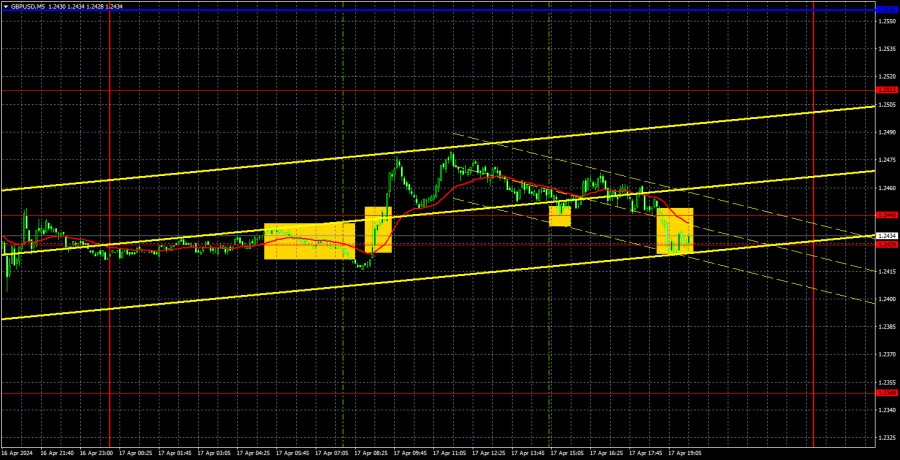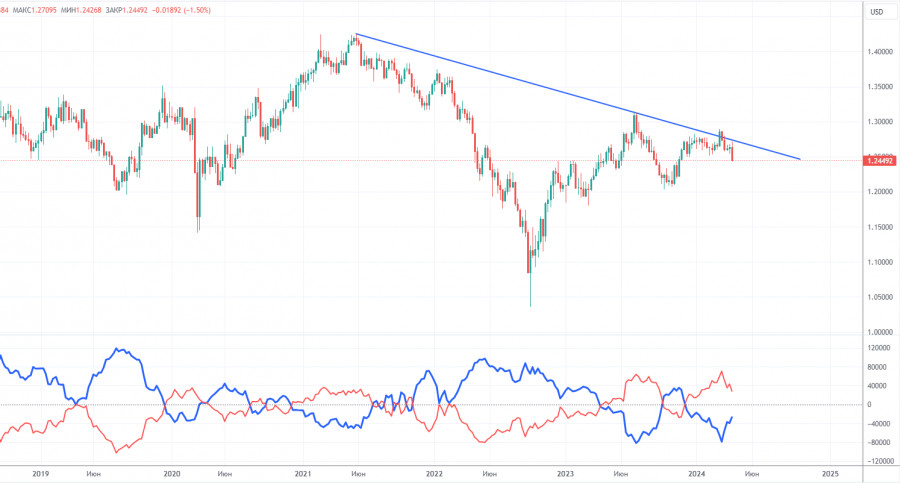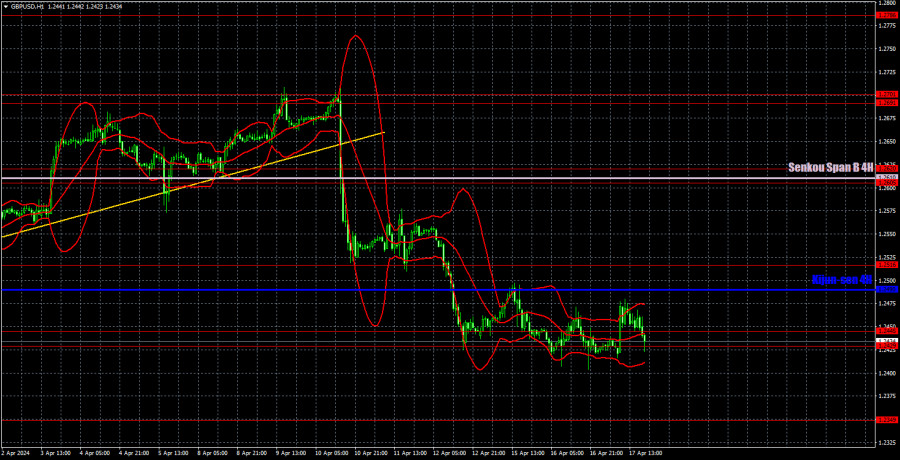Analysis of GBP/USD 5M
GBP/USD continued to trade sideways on Wednesday. Volatility remains weak, and traders took a break after leaving the 4-month sideways channel. The price is currently 80 pips below the channel where it spent almost half a year. Therefore, we still expect the pound to fall, and take note that there has always been a reason to sell the pound since three months ago.
Yesterday, the UK released its inflation report for March. It's hard to say if it pleased or disappointed traders. Judging by their reaction, they were pleased, but only for a brief moment. The pound managed to rise by 50 pips as inflation decreased less than forecasted. However, in general, this doesn't change anything. UK inflation is already lower than US inflation, which means the Bank of England may move to lower the key rate faster than the Federal Reserve. Consequently, the British currency, which was already expected to decline, even has more reasons to move lower. However, the market, as before, is in no hurry to sell the pound for dollars. Perhaps the BoE is still secretly conducting interventions.
The trading signals on Wednesday were strange. At the very beginning of the European session, a sell signal was formed, but it should not have been executed as the UK inflation report was scheduled to be released in 15 minutes. When it was published, the price settled above the range of 1.2429-1.2445, and this signal could have been executed with a long position. However, the pair did not sharply rise, and the trade closed at breakeven with a Stop Loss. During the US session, the pair bounced off the level of 1.2445, but the upward movement was even weaker. Therefore, there were no profits on Wednesday since the movements were too weak.
COT report:
COT reports on the British pound show that the sentiment of commercial traders has frequently changed in recent months. The red and blue lines, which represent the net positions of commercial and non-commercial traders, constantly intersect and, in most cases, remain close to the zero mark. According to the latest report on the British pound, the non-commercial group closed 18,400 buy contracts and 3,200 short ones. As a result, the net position of non-commercial traders decreased by 15,200 contracts in a week. The fundamental background still does not provide a basis for long-term purchases of the pound sterling, and the currency finally has a real chance to end the flat period. The trend line on the 24-hour TF clearly indicates what trend we are currently in.
The non-commercial group currently has a total of 80,000 buy contracts and 51,700 sell contracts. The bulls no longer have a significant advantage. Therefore, the pound has a huge potential to fall. We can only hope that inflation in the UK will not start to accelerate, or that the Bank of England will not intervene.
Analysis of GBP/USD 1H
On the 1H chart, GBP/USD has left the sideways channel of 1.25-1.28. A downtrend may resume, and the pair has the potential to fall by at least 400-500 pips. The fundamental and macroeconomic background continues to support the dollar, as the US economy is much stronger than the UK, and the Fed keeps pushing back its first rate cut. As a result, even the BoE may lower its key rate sooner, and this will weigh on the pound.
As of April 18, we highlight the following important levels: 1.2215, 1.2269, 1.2349, 1.2429-1.2445, 1.2516, 1.2605-1.2620, 1.2691-1.2701, 1.2786, 1.2863, 1.2981-1.2987. The Senkou Span B line (1.2610) and the Kijun-sen line (1.2490) lines can also serve as sources of signals. Don't forget to set a Stop Loss to breakeven if the price has moved in the intended direction by 20 pips. The Ichimoku indicator lines may move during the day, so this should be taken into account when determining trading signals.
On Thursday, there are no important events scheduled in the UK, and the US will only release secondary reports. Therefore, it is more likely that the flat will persist today, and volatility will be very low again. However, for now, the pound maintains a downward trend.
Description of the chart:
Support and resistance levels are thick red lines near which the trend may end. They do not provide trading signals;
The Kijun-sen and Senkou Span B lines are the lines of the Ichimoku indicator, plotted to the 1H timeframe from the 4H one. They provide trading signals;
Extreme levels are thin red lines from which the price bounced earlier. They provide trading signals;
Yellow lines are trend lines, trend channels, and any other technical patterns;
Indicator 1 on the COT charts is the net position size for each category of traders;















